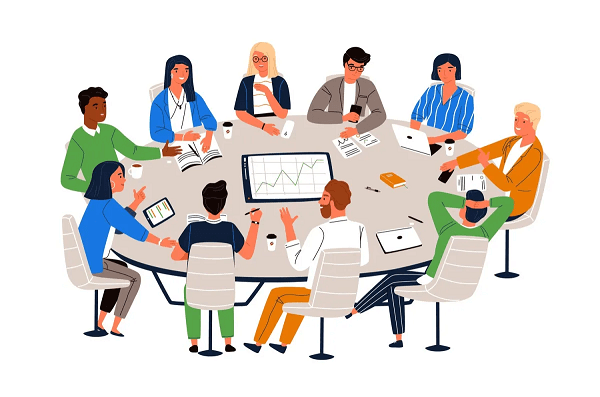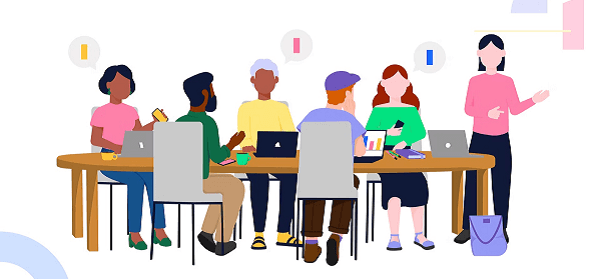Advantages and Disadvantages of Group Decision MakingDecision MakingDecision-making is a process of choosing from a set of alternatives in the course of action to achieve the alternatives. 
Basic Characteristics of Decision Making
Group Decision Making
In group decision-making, the members interact with each other, deliberate on the issue, and conclude. In group decision-making, managers at the same or different levels sit together, ponder over the problem, jointly deliberate information and alternatives are hammered out, and collectively assume the responsibility for decisions. The Board of Directors in the company is a remarkable example of group decision-making. The groups undertake key decisions of the corporation that includes key policy decisions, setting up of plants, and going into a joint venture. At the middle and junior management levels, there may be a committee of executives of the same or different departments to take collective decisions, including a coordination committee, purchase committee, etc. Firms are comprised of individuals and groups, both informal and formal groups have to decide to resolve their issues. The decision can be arrived at through either consensus or a simple majority. Consensus means that all group members consent and agree to the proposed decision. In contrast, the majority means that it is enough for the majority of the group members to agree on the decision to be arrived on. Techniques for Group Decision MakingSome of the techniques for group decision-making involve:
1. BrainstormingThe primary goal of brainstorming is to generate ideas rather than analyze ideas. Alex F. Osborn is credited for the development of this technique. Members involved in the brainstorming range from 5 to 10. They sit in the classroom techniques and generate ideas from the free interaction. The leader of the team identifies the issue and explains it to the team members and the rules that need to be followed. All these ideas are written on the blackboard for everybody to see so they can improve upon them. Basic Guidelines that are Observed During Brainstorming Sessions are:
The concept of brainstorming is very beneficial in the armed forces, agencies, and governmental and non-governmental organizations. An idea generated by the other may become a trigger point for the other member to suggest more ideas. The duration for an ideal brainstorming session is 40-60 minutes, but the brainstorming session is not hundred percent full proof, and it has some limitations:
3. Nominal Group TechniqueThe technique is applied when a fair amount of innovation and idea generation is employed. A nominal group exists only as the members have very few interactions before making a decision. It is a structured technique and unfolds through the following process:
This Technique has Primarily Two Advantages
Some of the Disadvantages of the Techniques are
3. Delphi TechniqueIt was developed by the Rand Corporation as a technique to gather experts' judgments for the application in developing the forecasts. It consists of 4 steps:
The process is repeated on several occasions until a consensus is reached. This technique is applied for:
It is time-consuming, but this limitation can be overcome using emails and electronic emissions. 4. Fish-Blowing TechniqueThe technique is a variation of the brainstorming process; however, it is more structural and focused. The group of experts sits in a circle with a single chair of the circle. One group member or leader is proposed to sit in the center of the chair and share his opinion of the issues and his solution proposition. The other group members can pose their questions, and crosstalk is prohibited. Once the member in the group has finished talking and his opinion is fully understood, he leaves the center of the chair and gives his opinion in light of the views expressed earlier. The members can throw their questions to the center based upon the new ideas presented by the member in the center and the ideas presented earlier. Sharing between the chair and the group members continues until each member's turn to occupy the central chair is over. All the members work on the same information, though their opinions differ on the issue. After all the experts have expressed their opinion from the centre chair, the group will discuss the recommended alternatives and conclude. 5. Quality CirclesIt is a work group of 8-10 employees and supervisors with shared responsibility areas. The member of the team often interact with each other once a week on the enterprise time, and company premises to discuss the quality of their problem, suggest solutions, examine the cause of the problem and take corrective measures. They are responsible for solving quality problems and producing and evaluating their opinions. However, the top executive has the ultimate control and takes the final call for proposed solutions. It is not presumed that employees can analyze and solve the issue. Therefore, part of the quality circle concept includes teaching the employee's group communication skills, measurement and problem analysis methods, and various quality strategies. Some typical efforts in improving production methods and quality involve reducing defects, downtime, scrap, and rework, which could lead to cost reduction and increased productivity. The technique of quality circle has been refined over the years. It is now followed by recognition of their achievements. Defects, scrap, rework, and downtime are also expected to lead to cost reduction. Achieve the Following Objectives:
(I) Quality circles have proved to be a valuable tool for increasing productivity, improving quality, and reducing wastage. (II) Forming quality circles in Japan and other countries have helped bring out several innovations in products and technology. (III) Quality circles help develop the participants as they are encouraged to Produce innovative ideas and find new ways to improve product quality. Individual vs. Group Thinking
Group decision-making is generally better than individual decision-making, and the reason is listed below:
Advantages of Group Decision Making
Disadvantages of the Group Decision Making
Next TopicAdvantages and Disadvantages of ICT
|
 For Videos Join Our Youtube Channel: Join Now
For Videos Join Our Youtube Channel: Join Now
Feedback
- Send your Feedback to [email protected]
Help Others, Please Share










